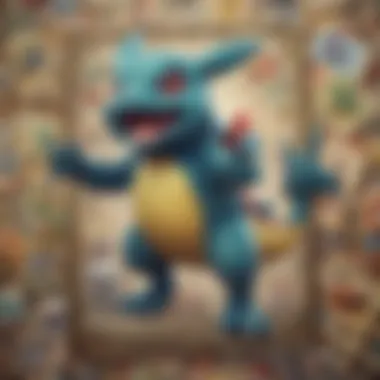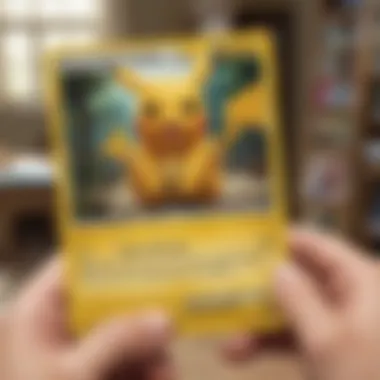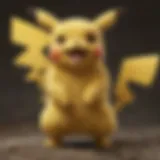Exploring the Price Dynamics of Pokémon Cards


Intro
The trading card game phenomenon that is Pokémon has captivated millions since its inception. Its collectible cards have become not just a pastime but a serious investment avenue. Collectors navigate this intricate landscape, hoping to unearth cards of significant value. The prices of Pokémon cards can fluctuate dramatically due to various factors. Understanding these price dynamics provides insights that can aid collectors and enthusiasts in making informed decisions.
This article will delve into the core aspects influencing the valuation of Pokémon cards, including rarity, condition, demand trends, and historical context. We will explore market insights, historical price patterns, and essential valuation factors. Each aspect enriches the collector's comprehension of the market, driving smarter buying and trading choices.
Preamble to Pokémon Collectible Cards
Pokémon collectibles, particularly trading cards, have become a significant aspect of pop culture and investment. Understanding their price dynamics allows enthusiasts to make informed decisions, whether for personal enjoyment or investment purposes. This section will outline the basics of Pokémon collectible cards, emphasizing their appeal and significance in various contexts.
Overview of the Pokémon Trading Card Game
The Pokémon Trading Card Game (TCG) launched in 1996, quickly captivating players of all ages. The game involves strategy, collection, and competition, where players build decks and battle opponents. Each card features unique Pokémon characters, moves, and abilities, allowing for intricate game strategies.
The graphics and themes of the cards appeal to many; hence, they possess both entertainment and aesthetic value. Players often seek to collect complete sets or rarer cards, driving demand further. Some notable expansions include the Base Set, which introduced iconic characters such as Charizard and Pikachu, influencing player interest over decades. The game fosters a community of players and collectors, making it a dynamic and evolving experience.
Importance of Collectible Cards in Different Eras
Collectible cards have evolved through various eras in Pokémon's history. Each era reflects changes in gameplay, design, and audience engagement. In the early years, cards served primarily for game mechanics. As the fanbase grew and nostalgia developed, the cards gained status as collectible items.
During the late 90s and early 2000s, many early cards became sought after. More recently, with the rise of digital engagement and social media platforms, there has been a resurgence of interest in card collecting. This shift has transformed Pokémon cards into investment opportunities. Understanding these eras helps collectors identify trends and predict future value, influencing buying or selling decisions.
Learning about these dynamics is crucial for any potential collector or investor. By observing the past and present, they can better navigate the complex market landscape of Pokémon collectible cards.
Historical Price Trends
Understanding historical price trends is crucial for any collector, investor, or enthusiast of Pokémon collectible cards. The evolution of prices over time reflects various market dynamics, including supply, demand, and cultural phenomena. By analyzing these trends, one can gain insights into how card values have been influenced by external factors, such as significant events and changes in collector interest. This section will delve into the early years of the Pokémon card market and the remarkable shifts that took place during pivotal moments in its history. Recognizing these price movements helps collectors make informed decisions when buying or trading cards.
Early Years and Initial Market Growth
The Pokémon Trading Card Game was first introduced in 1996, quickly captivating audiences worldwide. In its initial years, the prices for collectible cards were relatively modest. Many players and collectors viewed these cards primarily as part of gameplay rather than investment assets. Common cards sold for mere cents, while some rarer ones could reach a few dollars.
This early market phase laid the groundwork for what was to come. The initial waves of interest drew in younger audiences, and parents began purchasing packs for their children, contributing to a growing base of collectors. Collectors began realizing the potential value of certain cards, especially those from the original Base Set, such as Charizard and Pikachu.
As popularity surged, the market underwent a transformation. The rise of online platforms facilitated a wider audience, and prices started to reflect this growing interest. Notably, early cards in excellent condition began to appreciate significantly in value. This initial growth was marked by a combination of gameplay demand and collector interest, setting up the stage for more rapid price fluctuations.
The Impact of the Pokémon Go Phenomenon
In 2016, the release of the augmented reality game Pokémon Go reignited interest in the Pokémon brand on an unprecedented scale. Suddenly, a new wave of both nostalgic fans and new players entered the scene. This resurgence had a profound impact on the collectible card market.
As individuals who previously had minimal interest in cards became engaged with the franchise, they turned to Pokémon trading cards as a tangible connection to the game. Many collectors began searching for their childhood cards or sought to purchase new ones, causing prices to skyrocket for various sets.
Some notable effects included:
- Increased demand for rare cards: Popular cards with nostalgic value, such as Charizard and various promotional cards, saw their prices soar due to renewed interest.
- Heightened awareness of collectibles: More individuals began recognizing Pokémon cards as valuable items, resulting in elevated prices across the board.
- Emergence of collecting as an investment: Many new collectors started viewing cards not just as hobby items but as investment opportunities, often leading to frenzied buying in certain segments of the market.
The 2016 phenomenon serves as a case study, illustrating how external factors can significantly impact market prices. Observing such trends allows collectors to anticipate future movements based on similar cultural events or societal shifts.


Factors Influencing Card Prices
Understanding the factors that influence Pokémon card prices is critical for collectors and investors alike. The collectible card market is dynamic, with various elements affecting how much a card is worth at any given time. By examining these factors, individuals can make more informed decisions when acquiring or selling cards, optimizing their collections and investments.
Rarity and Limited Editions
Rarity is a fundamental aspect that significantly impacts card value. A card's rarity often depends on how many copies have been produced. For example, cards from the base set, especially first edition holographic cards, tend to command higher prices due to their limited availability. Similarly, cards released as part of special sets or promotional events can also hold greater value.
Limited-edition cards often entice collectors who seek unique items. These cards can be especially valuable if they feature iconic characters like Charizard or Pikachu. The limited nature of such releases makes them more desirable, driving up their price in the market. Collectors tend to view these cards not just as playthings but as investments that can appreciate over time.
Condition and Grading Systems
The physical condition of a Pokémon card plays a pivotal role in its market price. Cards that are well-preserved, without scratches or bends, are more appealing to buyers. Grading systems provide a standard to assess a card's condition, with companies like PSA (Professional Sports Authenticator) and Beckett Grading Services assigning scores ranging from 1 to 10. Higher grades translate into higher values.
For instance, a PSA 10 gem mint Charizard can sell for thousands of dollars, while the same card in a lower grade may only fetch a fraction of that price. Collectors invest time and money into seeking out the best-graded cards, knowing that the higher the grade, the greater the potential return on investment.
Market Demand and Trends
Market demand fluctuates based on various influences, including popular culture, nostalgia, and new game releases. The resurgence of interest in Pokémon, particularly with games like Pokémon Go, has led to spikes in demand, affecting pricing across the board. Demand can also be driven by social media trends and influencer endorsements, which often spark renewed interest in specific cards or sets.
Keeping an eye on current trends is essential for collectors. By observing which cards are gaining popularity and which are declining in value, collectors can better navigate their buying and selling strategies. Websites such as eBay and marketplaces provide data that can help understand price changes over time.
Current Market Landscape
The current market landscape for Pokémon collectible cards is characterized by its vibrant dynamics and fluctuating values. Understanding this landscape is essential for enthusiasts and collectors. Price levels can vary significantly based on factors such as card rarity, condition, and the overall demand within the market. Assessing the current state helps card owners realize potential selling opportunities and informs buyers about their investment choices. Furthermore, a grasp of the market landscape allows stakeholders to navigate the complexities of card valuation systematically.
Popular Cards with High Market Value
Certain cards within the Pokémon universe stand as icons, showcasing high market values. For instance, the Pikachu Illustrator card is widely regarded as one of the most valuable, with prices reaching unprecedented heights in auctions. Another example is the 1999 Holo 1st Edition Charizard, which consistently draws the attention of serious collectors due to its nostalgic value and limited availability.
- Pikachu Illustrator
- 1999 Holo 1st Edition Charizard
- 1998 Trophy Pikachu
- Estimated value: $250,000+
- Rarity: Only 20-30 known copies printed.
- Recent auction price: $200,000
- Significance: Represents a key moment in Pokémon history.
- Recent sale: $100,000+
- Awarded in tournaments, further enhancing its desirability.
Collectors must stay informed about these high-value cards. Market fluctuations can influence their worth, and knowledge about their rarity contributes to smarter buying and selling decisions.
Platforms for Buying and Selling Cards
In today's market, various platforms facilitate the buying and selling of Pokémon cards. Websites like eBay and TCGPlayer serve as primary marketplaces where collectors and investors can engage in transactions. Social media platforms also play a significant role in connecting buyers with sellers. For example, Facebook groups dedicated to Pokémon card trading provide a space for enthusiasts to negotiate deals and stay updated on market trends. Furthermore, more specialized platforms like PWCC Marketplace cater to serious investors looking for high-end collectibles.
- eBay: Accessible and widely used for selling and bidding.
- TCGPlayer: Known for pricing guides and a strong community for trading.
- Facebook Groups: Active communities that allow for informal exchanges.
- PWCC Marketplace: Focused on premium trading cards and auctions.
Navigating these platforms requires understanding fees, shipping considerations, and community standards. Engaging with reputable sellers and verifying card conditions before purchasing is crucial.


Casual Collectors versus Serious Investors
The Pokémon card market accommodates a wide range of participants, from casual collectors to serious investors. Casual collectors often purchase cards for personal enjoyment, nostalgia, or as a hobby. They may prioritize completing their collections for sentimental reasons, often not focused on financial gain. For them, the aspect of fun and community involvement is often more important.
In contrast, serious investors target cards primarily as financial assets. Their strategies involve studying trends, analyzing historical data, and making calculated purchases. They may focus on cards that are likely to appreciate in value over time, such as limited editions or market-resilient favorites. For example, serious investors may frequently revisit market-performing cards like the 1999 Holo 1st Edition Charizard to assess how their value changes in response to market trends and demand.
Collecting might begin as a casual experience, but understanding the potential for investment can influence how individuals engage with the hobby. Both casual collectors and serious investors contribute to the market's vibrancy, each with unique motivations and goals.
This diversity in participation enriches the Pokémon card community, leading to a healthy marketplace characterized by enthusiasm and investment potential.
Analyzing Specific Card Values
Analyzing specific card values is crucial for enthusiasts and collectors within the Pokémon card market. The nuances within this analysis impact buying, trading, and selling decisions significantly. Understanding how values are determined enables collectors to make informed choices, whether they are casual hobbyists or serious investors.
Elements like rarity, condition, and historical significance interplay to affect card valuation. Additionally, knowledge of specific cards that hold iconic status in the community adds an extra layer of understanding. This section will delve into these aspects, providing valuable insights.
Iconic Cards and Their Valuations
Iconic cards represent the pinnacle of value within the Pokémon collectible card landscape. Cards like the Venusaur, Charizard, and Blastoise from the original base set hold immense appeal due to their nostalgic value and rarity. Their worth can reach thousands of dollars, contingent on condition and grading.
The 2006 Pikachu Illustrator Card is another quintessential example. Only a few exist, making it one of the rarest cards. Some collectors regard it as "the holy grail" of Pokémon cards. Prices for this card can soar beyond $200,000 in peak condition.
Factors influencing the valuation of these iconic cards include:
- Rarity: The fewer the prints, the higher the value.
- Condition: Higher graded cards, such as those rated by PSA or BGS, command premium prices.
- Popularity: Cards featuring fan-favorite characters often maintain higher value.
Each iconic card tells a story and contributes to the broader tapestry of collectible gaming. It is essential to maintain awareness of shifting trends, as market demand can change rapidly based on external factors like new game releases or trends in social media discussions.
Comparison of Older vs. Newer Cards
The distinction between older and newer Pokémon cards is significant in the valuation context. Older cards, particularly from the early 90s, tend to retain higher value due to their historical importance and nostalgia attached to them. For example, the first edition holographic cards typically see much greater prices compared to their modern counterparts.
Newer cards, while still valuable, often do not match the prices of their older relatives. However, certain special edition or limited print cards, such as those released during promotional events, can achieve impressive valuations. For instance, limited boxes released for Pokémon’s 25th anniversary included exclusive cards that might rise in value over time.
Here are key considerations for comparing older and newer cards:
- Historical Context: Older cards often come with a narrative that newer cards lack.
- Scarcity: The print runs of older cards were typically lower than many current sets.
- Market Trends: Interest in nostalgic products can inflate the prices of older cards compared to new releases.
The Role of Social Media in Pricing
Social media has a significant effect on the pricing dynamics of Pokémon collectible cards. Platforms such as Facebook, Instagram, and Reddit serve as vital spaces for collectors, investors, and enthusiasts to exchange information and ideas. This interconnectedness accelerates the flow of information regarding pricing, availability, and market trends. The influence of social media cannot be understated, as it shapes public perception and demand for specific cards. As the online community grows, so too does its impact on evaluations and trading norms.
Influencers and Their Impact on Card Value
Influencers play a crucial role in the Pokémon card market. They can sway the opinions of fans and collectors, often leading to surges or declines in card prices. Social media personalities showcase their collections, provide tutorials on card grading, and share insights on market trends. Their reach can elevate the status of certain cards, sometimes irrationally inflating their prices.
For example, if a popular influencer posts on their Instagram about a specific card, it can lead to a spike in demand. Notable influencers also engage in live streams where they open rare packs, creating excitement that blindsides other trends. Interest can escalate, causing prices to rise shortly after a post.


Factors influencing the overall valuation may include:
- Scarcity: When influencers spotlight a limited card, collectors often scramble to obtain it.
- Authenticity: An endorsement from a trusted source creates a sense of credibility around particular cards.
Online Communities and Price Discussion
Online communities serve as arenas for discussion about pricing and trends. Websites like Reddit host dedicated subreddits where collectors analyze prices and market movements in real-time. These discussions help buyers and sellers make informed decisions. Knowing what others are paying for similar cards provides context for one’s trading strategies.
Some benefits of engaging in price discussions include:
- Information Sharing: Collectors point out undervalued cards or emerging trends that others might overlook.
- Collaborative Learning: Newer collectors learn the ropes from seasoned enthusiasts, helping them avoid potential pitfalls.
- Clarification on Grading: Many discussions revolve around how grading affects perceived value, leading to better understanding among collectors.
Participants in these platforms must be vigilant. Information can be biased, and overreliance on any single source can skew perceptions of value. As discussions ebb and flow, prices can fluctuate based on the latest chatter, reinforcing the need for a critical approach to what is read online.
Future Trends in the Pokémon Card Market
Understanding the future trends in the Pokémon card market is essential for collectors and investors alike. This segment looks closely at emerging elements in the market that can shape the buying and selling landscape. Digital collectibles are becoming more prevalent, and the rise of these new technologies can influence traditional card valuations. With significant shifts occurring due to technology, social dynamics, and consumer preferences, it is vital to examine these factors to make informed decisions going forward.
Impact of Digital Collectibles
Digital collectibles have recently gained traction in the gaming community. Platforms like Pokémon TCG Online and various blockchain-based marketplaces showcase a new realm of collectibility. These digital assets essentially replicate the value proposition of physical cards, yet they provide unique features such as increased accessibility and easier trading.
The appeal of digital collectibles lies partly in their limited supply and the possibility of owning one-of-a-kind items. As collectors begin to embrace the digital version of Pokémon cards, traditional physical cards may see fluctuating values based on this growing interest.
Moreover, the interaction between physical cards and their digital counterparts will unfold. For instance, some players might prefer to use digital versions, especially for competitive play, while others will prioritize physical cards for collecting. This dual appeal can lead to a complex ecosystem where the demand for each type influences their pricing.
Predictions for Price Fluctuations
Price fluctuations are an expected characteristic of the Pokémon card market. Many variables contribute to these changes. Historical data shows that market demand can rise swiftly for certain cards due to media exposure, nostalgic triggers, or trending personalities in the Pokémon community. Collectors must keep an eye on such trends to anticipate when prices may increase or decrease.
In the next few years, it is likely that we will see:
- Increased integration of digital collectibles impacting physical card prices.
- A continued growth in interest fueled by social media and online communities, amplifying discussions about card valuations.
- Variance due to seasonal events like World Championships or Anniversary celebrations.
"As digital initiatives evolve, the intersection of digital and physical collectibles will be pivotal in shaping future values."
By staying informed on these trends, collectors can better navigate the Pokémon card market. Price predictions based on these insights enable more strategic investments. The balance between novelty and tradition will likely determine how prices fluctuate over time.
Epilogue
In this article, we explored the complex dynamics behind the prices of Pokémon collectible cards. Understanding these price fluctuations is crucial for collectors, investors, and enthusiasts alike. The Pokémon card market is influenced by various factors, including rarity, condition, and demand. This analysis not only provides historical context but also sheds light on current trends and future predictions. Knowing how these elements interact helps individuals make informed decisions when buying or selling cards.
Summary of Key Insights
Throughout the different sections of this article, we highlighted several key insights regarding Pokémon collectible cards:
- Historical Context: Prices have evolved significantly, especially during pivotal moments like the Pokémon Go craze.
- Valuation Factors: Rarity, condition, and market demand play a crucial role in determining card value.
- Current Landscape: The market sees a variety of players from casual collectors to serious investors, each affecting price dynamics differently.
- Social Influence: The rise of social media and online communities has reshaped how prices are discussed and advertised.
- Future Trends: Digital collectibles may shape the future of trading cards, impacting prices in unforeseen ways.
These insights form a solid foundation for anyone looking to navigate the Pokémon card market effectively.
Final Thoughts on Collecting Pokémon Cards
As collecting Pokémon cards becomes increasingly popular, the importance of understanding the market cannot be overstated. Collectors should focus on a few key areas:
- Education: Knowledge is power. Stay informed about trends, pricing, and the condition of cards.
- Community Engagement: Engage with communities on platforms like Reddit to share experiences and learn from others.
- Long-term Vision: Collecting should be enjoyable, but having a long-term perspective can help navigate down markets and fluctuations.







